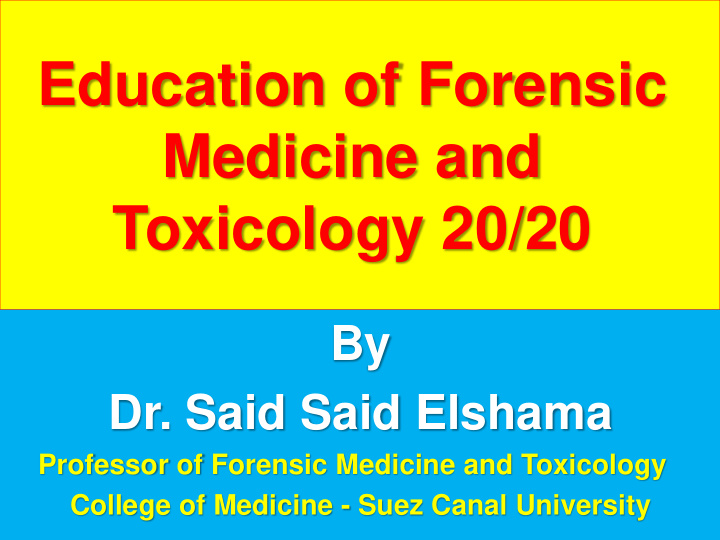



Education of Forensic Medicine and Toxicology 20/20 By Dr. Said Said Elshama Professor of Forensic Medicine and Toxicology College of Medicine - Suez Canal University
Objectives 1- Principles of Egyptian Medical Schools Development 20/20. 2- How to distribute and integrate Forensic and Toxicology Curriculum ? 3- Blueprint for Forensic and Toxicology Curriculum 20/20 . 4- How to introduce the new curriculum to students? 5- How to assess the students in new Curriculum ?
Principles of Egyptian Medical Schools Development 20/20
It runs in 5 years Teaching is System or 2 years internship Module-Based It divides into 2-3 Phases or Spirals Integrated System Curriculum
Directions of Integration 1- Horizontal Integration: The integration within basic science subjects or within clinical science subjects of the curriculum. 2- Vertical Integration: The integration between the basic and clinical science sections of the curriculum. 3- Spiral integration: (Ideal Form) It is a combination of both horizontal and vertical. • First spiral : (1 st “ 2-2.5 years”) Basic science (70 %) clinical science (30%) • Second spiral: Clinical science (70%) and basic science (30%)
„H‟ shaped curriculum is converted into „Z‟ shaped curriculum
Phases of integrated system 1- The first phase - foundation “ 1 year” Introduction to the basic medical information 2- The second phase “ 2 years” It is an organ system modules, applies the basic knowledge to the study of clinical disease. 3- The third phase “ 2 years” It is devoted to clinical aspect. 4- Longitudinal Curricular Themes (courses) It runs within multiple modules (Ethics, Medical Nutrition and Patient Safety) . 5- Internship
Credit Hours System • Credit hours of the course depend on the unit of the semester credit hour. • Semester credit hours are based on contact hours. • Contact hours are the spent time of student with an instructor whether face-to-face or virtual. • A semester is 15 weeks of instruction + one week for final examinations. • There are obligatory, elective and pre-requisite courses - university and college requirements. • Academic monitoring. • Registration, addition, deletion, withdrawal, postpone
Rules of Distribution and Integration of Forensic and Toxicology Curriculum The subject should be :- 1- In agreement with ILOS of educational module. 2- Common forensic and toxic issues in community (general needs assessment). 3- Have an impact on the patient and society. 4- Clarified in cognitive (knowledge), affective (attitude, counseling, communication skills), psychomotor domains. 5- In harmony with credit hours policy of module and medical branch. 6- In longitudinal courses if it is missed.
Blueprint Forensic and Toxicology Curriculum 20/20
Integrated Curriculum
Integrated Curriculum
How to introduce the new curriculum to students? 1- Lecture 2- Shared lecture 3- Problem based learning (Group discussion) 4- Seminar (tutorial) 5- Simulation A- Simulator (manikins) B- Role play 6- Audiovisual Material (virtual autopsy) 7- Self study (self directed learning)
Missed of Difficult task some medical subjects Integrated Curriculum Defects Fragmentation Dissatisfaction of Learning 100% about allotted subjects Integration time & information is not in the modules possible
How to assess the students in new Curriculum ? 1- Formative and Summative Assessments. 2- Distribution of questions according to ILOS and the given time to every subject (TOS). Assessment Methods A- MCQs, EMQ B- OSCE C- OSPE D- Logbook E- Portfolio
Appendix
Problem solving (Forensic Scenario without Task ) • First session: Brain storming • Second session: Debriefing
Forensic Scenario with Task
Toxicological Scenarios
MCQs based on Scenario
Extended Matching Question (EMQ)
Portfolio
Thank you
Recommend
More recommend